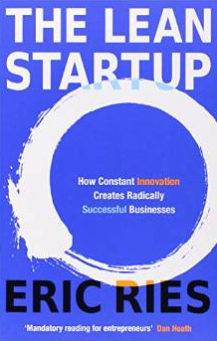I recently read The Lean Startup: How Today’s Entrepreneurs Use Continuous Innovation to Create Radically Successful Businesses by Eric Ries. Below are the quotes I found most interesting. As always, if you like the quote, click here to buy the book.
 “Startups exist not just to make stuff, make money, or even serve customers. They exist to learn how to build a sustainable business.” (9)
“Startups exist not just to make stuff, make money, or even serve customers. They exist to learn how to build a sustainable business.” (9)
“The goal of a startup is to figure out the right thing to build – the thing customers want and will pay for – as quickly as possible.” (20)
“Every new version of a product, every new feature, and every new marketing program is an attempt to improve this engine of growth.” (21)
“In general management, a failure to deliver results is due to either a failure to plan adequately or a failure to execute properly. Bother are significant lapses, yet new product development in our modern economy routinely requires exactly this kind of failure on the way to greatness.” (24)
“When you have only one test, you don’t have entrepreneurs, you have politicians, because you have to sell. Out of a hundred good ideas, you’ve got to sell your idea. So you build up a society of politicians and salespeople. When you have five hundred tests you’re running, then everybody’s ideas can run. And then you create entrepreneurs who run and learn and can retest and relearn as opposed to a society of politicians.” (33)
“Brad Smith explained to me how they hold themselves accountable for their new innovation efforts by measuring two things: the number of customers using products that didn’t exist three years ago and the percentage of revenue coming from offerings that did not exist three years ago.” (35)
“Lean thinking defines value as providing benefit to the customer; anything else is waste.” (48)
“What if we simply had offered customers the opportunity to download the product from us solely on the basis of its proposed features before building anything? Remember, almost no customers were willing to use our original product, so we wouldn’t have had to do much apologizing when we failed to deliver. (Note that this is different from asking customers what they want. Most of the time customers don’t know what they want in advance.)” (49)
“The effort that is not absolutely necessary for learning what customers want can be eliminated. I call this validated learning because it s always demonstrated by positive improvements in the startup’s core metrics.” (49)
“We adopted the view that our job was to find a synthesis between our vision and what customers would accept; it wasn’t to capitulate to what the customers thought they wanted or to tell customers what they ought to want.” (50)
“The irony is that it is often easier to raise money or acquire other resources when you have zero revenue, zero customers, and zero traction than when you have a small amount. Zero invites imagination, but small numbers invite questions about whether large numbers will ever materialize.” (52)
“The two most important assumptions entrepreneurs make are what I call the value hypothesis and the growth hypothesis. The value hypothesis tests whether a product or service really delivers value to customers once they are using it… The growth hypothesis tests how new customers will discover a product or service.” (61)
“The point is not to find the average customer but to find early adopters: the customers who feel the need for the product more acutely. Those customers tend to be more forgiving of mistakes and are especially eager to give feedback.” (62)
“As Mark Cook says, “Success is not delivering a feature; success is learning how to solve the customer’s problem.”” (66)
“What differentiates the success stories from the failures is that successful entrepreneurs had the foresight, the ability, and the tools to discover which parts of their plans were working brilliantly and which were misguided, and adapt their strategies accordingly.” (84)
“The problem with most entrepreneurs’ plans is generally not that they don’t follow sound strategic principles but that the facts upon which they are based are wrong.” (91)
“Before new products can be sold successfully to the mass market, they have to be sold to early adopters. These people are a special breed of customer. They accept – in fact prefer – an 80 percent solution; you don’t need a perfect solution to capture their interest.” (94)
“Early adopters are suspicious of something that is too polished: if it’s ready for everyone to adopt, how much advantage can one get by being early?” (95)
“These discussion of quality presuppose that the company already knows what attributes of the product the customer will perceive as worthwhile. In a startup, this is a risky assumption to make. Often we are not even sure who the customer is.” (107)
“Customers don’t care how much time something takes to build. They care only if it serves their needs.” (109)
“Part of the special challenge of being a startup is the near impossibility of having your idea, company, or product be noticed by anyone, let alone a competitor.” (111)
“A head start is rarely large enough to matter, and time spent in stealth mode – away from customers – is unlikely to provide a head start. The only way to win is to learn faster than anyone else.” (111)
“A good design is one that changes customer behavior for the better.” (120)
“Instead of writing a specification for a new feature that described it in technical terms, Farb would write a story that described the feature from the point of view of the customer. That story helped keep the engineers focused on the customer’s perspective throughout the development process.” (132)
“There is no bigger destroyed of creative potential than the misguided decision to persevere.” (149)
“Failure is a prerequisite to learning. The problem with the notion of shipping a product and then seeing what happens is that you are guaranteed to succeed – at seeing what happens.” (154)
“Customer segment pivot is keeping the functionality of the product the same but changing the audience focus.” (156)
“This is also common with pivots; it is not necessary to throw out everything that came before and start over. Instead, it’s about repurposing what has been built and what has been learned to find a more positive direction.” (169)
“Once you have found success with early adopters, you want to sell to mainstream customers. Mainstream customers have different requirements and are much more demanding.” (170)
“Large batches tend to grow over time. Because moving the batch forward often results in additional work, rework, delays, and interruptions, everyone has an incentive to do work in ever-larger batches, trying to minimize this overhead. This is called the large-batch death spiral because, unlike in manufacturing, there are no physical limits on the maximum size of a batch.” (198)
“Process is the only foundation upon which a great company culture can develop. But without this foundation, efforts to encourage learning, creativity, and innovation will fall flat.” (204)
“Sustainable growth is characterized by one simple rule: New customers come from the actions of past customers… Either by 1. Word of mouth… 2. As a side effect of product usage… 3 Through funded advertising… 4. Through repeat purchase or use.” (207-8)
“For advertising to be a source of sustainable growth, the advertising must be paid for out of revenue, not one-time sources such as investment capital.” (208)
“Getting a startup’s engine of growth up and running is hard enough, but the truth is that every engine of growth eventually runs out of gas. Every engine is tied to a given set of customers and their related habits, preferences, advertising channels, and interconnections. At some point, that set of customers will be exhausted. This may take a long time or a short time, depending on one’s industry and timing.” (222)
“If you are causing (or missing) quality problems now, the resulting defects will slow you down later. Defects cause a lot of rework, low morale, and customer complaints, all of which slow progress and eat away at valuable resources.” (227)
“In my experience startup teams require three structural attributes: scarce but secure resources, independent authority to develop their business, and a personal stake in the outcome.” (253)
Liked the quotes? Buy the book here.

